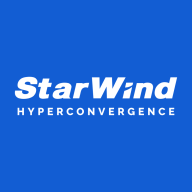

StarWind HyperConverged Appliance and Red Hat Hyperconverged Infrastructure compete in the hyperconverged infrastructure market. StarWind's cost-effective approach gives it an advantage for budget-conscious buyers, while Red Hat appeals to those prioritizing advanced features despite its higher price point.
Features: StarWind HyperConverged Appliance is known for simplicity and efficiency, offering high availability and seamless integration with existing systems. It provides synchronous replication and an intuitive management interface. On the other hand, Red Hat Hyperconverged Infrastructure focuses on scalability and flexibility, meeting a broad range of enterprise needs. It supports comprehensive automation tools and can handle larger, more complex environments.
Room for Improvement: StarWind could improve by enhancing the scalability options and adding more advanced automation features. Documentation could also be more comprehensive. Meanwhile, Red Hat might work on simplifying the deployment process, reducing its complexity for users without specialized IT skills, and offering more competitive pricing to attract smaller organizations.
Ease of Deployment and Customer Service: StarWind is commended for its straightforward deployment process and highly responsive customer support, not requiring specialized IT knowledge. Red Hat, while providing a detailed deployment plan, tends to be more complex and requires in-depth understanding. However, its extensive documentation and dedicated service teams are assets for navigating the setup process.
Pricing and ROI: StarWind HyperConverged Appliance is attractive for small to medium-sized businesses due to its lower setup cost and quick ROI, leveraging an efficient design and competitive pricing model. In contrast, Red Hat Hyperconverged Infrastructure demands a higher initial investment but offers scalability and long-term value, which many find justifies the cost in diverse and expanding enterprise environments.
| Product | Market Share (%) |
|---|---|
| StarWind HyperConverged Appliance | 1.1% |
| Red Hat Hyperconverged Infrastructure | 0.9% |
| Other | 98.0% |

| Company Size | Count |
|---|---|
| Small Business | 1 |
| Large Enterprise | 6 |
| Company Size | Count |
|---|---|
| Small Business | 50 |
| Midsize Enterprise | 22 |
| Large Enterprise | 8 |
Red Hat Hyperconverged Infrastructure - based on our leading OpenStack and virtualization platforms - provides co-located, scalable, software-defined compute and storage, driven by Red Hat Ansible Automation on economical, industry-standard hardware.
For SMB, ROBO and Enterprises, who look to bring in quick deployment and operation simplicity to virtualization workloads and reduce related expenses, our solution is StarWind HyperConverged Appliance (HCA). It unifies commodity servers, disks and flash, hypervisor of choice, StarWind Virtual SAN, Microsoft Storage Spaces Direct or VMware Virtual SAN and associated software into a single manageable layer. The HCA supports scale-up by adding disks and flash, and scale-out by adding extra nodes.
StarWind HyperConverged Appliance consists of StarWind Virtual SAN, Microsoft Storage Spaces Direct or VMware Virtual SAN “Ready Nodes”, targeting those, who are building their virtualization infrastructure from scratch. In case there is an existing set of servers, we offer a “software only version”, which is essentially our years proven StarWind Virtual SAN. Basically, it’s the fuel powering StarWind HCA.
We monitor all HCI reviews to prevent fraudulent reviews and keep review quality high. We do not post reviews by company employees or direct competitors. We validate each review for authenticity via cross-reference with LinkedIn, and personal follow-up with the reviewer when necessary.